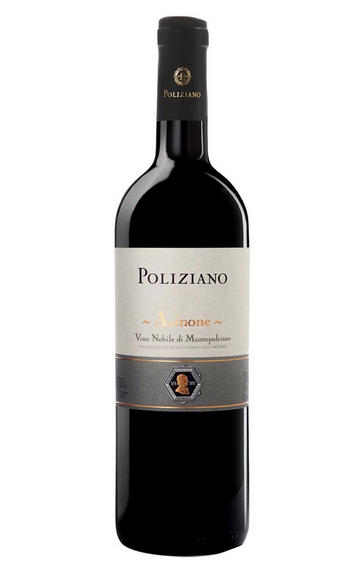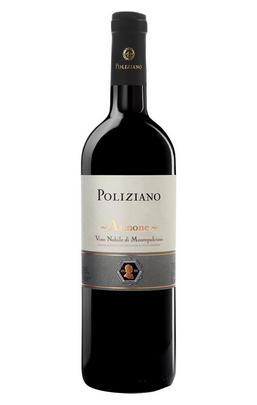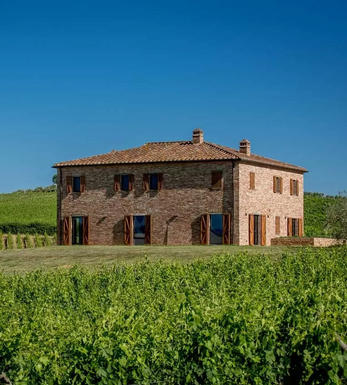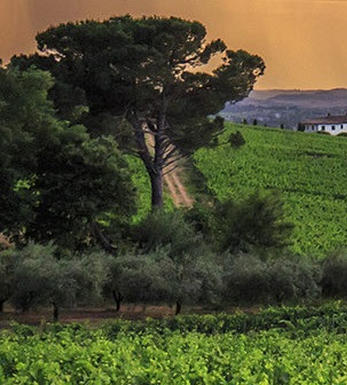
2017 Vino Nobile di Montepulciano, Asinone, Poliziano, Tuscany, Italy

Critics reviews
The 2017 Vino Nobile di Montepulciano Asinone is ample and creamy, with all of the natural radiance of the year on display. Ripe red cherry, rose petal, cedar, lavender and spice all build as this extroverted Vino Nobile shows off its considerable allure. Even with all of its exotic beauty, the 2017 retains quite a bit of energy and plenty of structure, with a good deal of translucent vibrancy as well. In a word: superb.
Drink 2022 - 2032
Antonio Galloni, Vinous.com (April 2021)
The 2017 Vino Nobile di Montepulciano Asinone is the newest edition of one of the classic and historic wines of the appellation. This hot-vintage expression shows soft, velvety and dark fruit with plenty of cherry and blackberry. Asinone was conceived as a modern and contemporary expression of Vino Nobile, and it remains that today. Like many of its peers, I found the tannins to be less integrated in 2017, and I would recommend a hearty meat pairing to counter some of that astringency.
Drink 2020 - 2028
Monica Larner, Wine Advocate (December 2020)
A generous, beautiful Vino Nobile with cherry, walnut and chocolate character. Firm, lightly chewy tannins give this wine form and verve. It’s long and lively with beautiful firmness and polish.
Drinkable now, but better in 2022.
James Suckling, JamesSuckling.com (August 2020)
The Asinone vineyard sits on an ancient hill that was once surrounded by sea. The clay soil is rich in fossils and minerals, yielding small bunches with small berries and thick skins that give substantial structure. It is still a bit closed, though aromas of macerated cherry and vanilla poke through. The palate brings in some savoury notes along with plum and cedar. Robust, intense and dense with austere, forceful tannins, this mouthful will need some time in the cellar.
Drink 2023 - 2031
Michael Morris, Decanter.com (April 2021)
About this WINE

Azienda Agricola Poliziano
Located in the heart of Tuscany, specifically in the Montepulciano region, Azienda Agricola Poliziano was founded by Dino Carletti in 1961 and named after the Renaissance poet Angelo Ambrogini, known as “Il Poliziano.” The winery has become synonymous with producing high-quality Vino Nobile di Montepulciano, embracing traditional winemaking techniques alongside modern innovations.
Poliziano is celebrated for its meticulous vineyard management, focusing on cultivating Sangiovese grapes, especially the local Prugnolo Gentile clone. This attention to detail is evident in their wines, which consistently exhibit the unique characteristics of the terroir. The estate produces various wines, including Vino Nobile di Montepulciano, Rosso di Montepulciano, and Super Tuscans.
The wines are known for their elegance, complexity, and the expression of Montepulciano’s distinct soil and climate. The winery combines traditional winemaking methods and modern technology to craft wines that reflect tradition and innovation. Their commitment to quality has earned them international recognition and a loyal following among wine enthusiasts.

Vino Nobile di Montepulciano
Vino Nobile di Montepulciano is one of three great Sangiovese DOCG zones in Tuscany (along with Chianti Classico and Brunello di Montalcino) and certainly the oldest and the smallest.
Montepulciano wine was first documented in 789 AD when a cleric, Arnipert, offered the church of San Silvestre some vineyards attached to the castle of Policiano; in his `Historical & Geographical Dictionary of Tuscany' Repetti mentions the trade in Montepulciano wines from 1350. In the mid-16th century Pope John III's cellarman praised the region's wine as `perfect in both winter and summer; aromatic, fleshy, never sour nor brightly-coloured, because it is a wine fit for a Nobleman' while in his ode `Bacchus in Tuscany' (1685) Redi triumphantly proclaims that `Montepulciano is the king of all wines!' Despite all this, wines from Montepulciano clearly lost their lustre in the 19th century when they were mostly labelled and sold as Chianti. With the creation of the Vino Nobile di Montepulciano DOC in the 1960s, and its promotion to DOCG status in 1980, however, the region's identity and focus was firmly restored.
The Vino Nobile di Montepulciano DOCG covers only 820ha - compared to 12,000ha for Brunello di Montalcino and 7,000ha for Chianti Classico. Located an hour's drive east of Montalcino, the hilltop town of Montepulciano and its surrounding vineyards lie at between 250m and 600m altitude. The finest vineyards are situated about 300m above sea-level on south-east facing slopes made up of a mix of sandy, gravelly, clay soils.
Sangioveseand Prugnolo Gentile (a more open, larger-berried clone of Sangiovese) account for at least 70% of the blend along with a maximum 20% Canaiolo and a maximum 20% from other permitted varieties. The latter include the highly regarded local variety, Mammolo, prized for its plummy perfume yet sadly increasingly losing out to international varieties like Merlot.
The maximum yield for Vino Nobile di Montepulciano is 56 hl/ha and the wine must be aged for 2 years from 1st January after the harvest, either entirely in oak, or 18 months in oak and 6 months in bottle, or 12 months in oak, 6 months in bottle and 6 months in other storage. Riserva wines must have a minimum alcohol content of 13% and must be aged for 3 years. All wines must be bottled within the commune of Montepulciano and must have a minimum dry extract of 23 g/l.
Stylistically, Vino Nobile di Montepulciano combines the richness of Brunello di Montalcino with the perfume of Chianti Classico. Without the limestone spine of other top Tuscan sites, the wines tend to be medium to full-bodied with firm tannins, lively acidity, fleshy strawberry and cherry fruit and hints of tea leaves. The best examples should age 8 to 15 years while Riservas can last for over two decades.
Recommended producer: Massimo Romeo.

Sangiovese
A black grape widely grown in Central Italy and the main component of Chianti and Vino Nobile di Montepulciano as well as being the sole permitted grape for the famed Brunello di Montalcino.
It is a high yielding, late ripening grape that performs best on well-drained calcareous soils on south-facing hillsides. For years it was blighted by poor clonal selection and massive overcropping - however since the 1980s the quality of Sangiovese-based wines has rocketed upwards and they are now some of the most sought after in the world.
It produces wines with pronounced tannins and acidity, though not always with great depth of colour, and its character can vary from farmyard/leather nuances through to essence of red cherries and plums. In the 1960s the advent of Super Tuscans saw bottlings of 100% Sangiovese wines, as well as the introduction of Sangiovese/Cabernet Sauvignon blends, the most famous being Tignanello.


Buying options
Add to wishlist
Description
The 2017 Vino Nobile di Montepulciano Asinone is ample and creamy, with all of the natural radiance of the year on display. Ripe red cherry, rose petal, cedar, lavender and spice all build as this extroverted Vino Nobile shows off its considerable allure. Even with all of its exotic beauty, the 2017 retains quite a bit of energy and plenty of structure, with a good deal of translucent vibrancy as well. In a word: superb.
Drink 2022 - 2032
Antonio Galloni, Vinous.com (April 2021)
wine at a glance
Delivery and quality guarantee